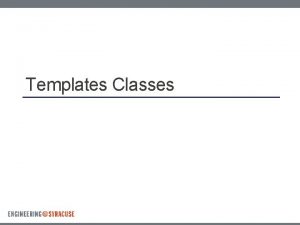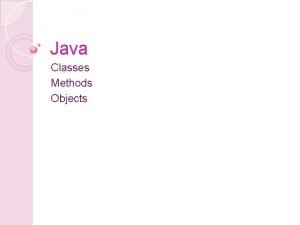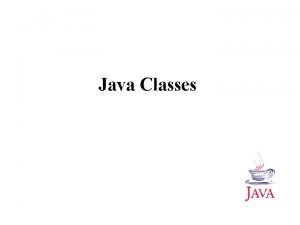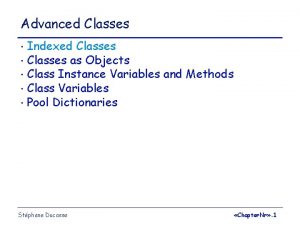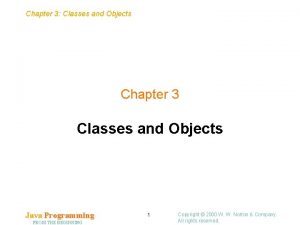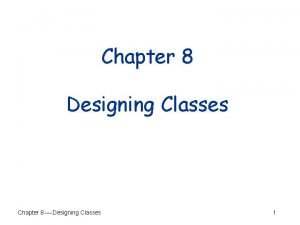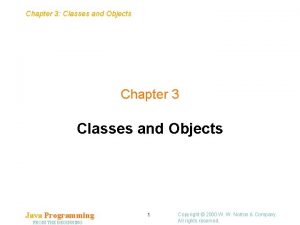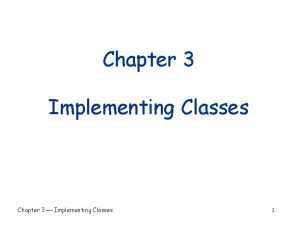CHAPTER 25 CLASSES 1 Topics Understanding Classes The














- Slides: 14

CHAPTER 25 CLASSES 1

Topics Understanding Classes – The Anatomy of a Class Inheritance – Superclasses and Subclasses – Virtual and Override 2

Understanding Classes are the key concept in Object-Oriented Programming A class is a definition of a type of object There can be many instances of a single class – Each person in this classroom could be thought of as an instance of the Human class C# classes combine data and functionality – Classes have variables, which are called fields – Classes have functions, which are called methods You're already using classes! – Each C# script you've written is a class Classes represent objects in your game 3

Understanding Classes Example: A character in a standard RPG – Fields you would want for each character string name; // The character's name float health; // The amount of health she has float health. Max; // Her maximum amount of health List<Item> inventory; // List of Items in her inventory List<Item> equipped; // A List of Items she has equipped – Methods you would want void Move(Vector 3 new. Loc) {…} // Moves her to new. Loc void Attack(Character target) {…} // Attacks target with the current weapon or spell void Take. Damage(float dmg. Amt) {…} // Reduces health void Equip(Item new. Item) {…} // Adds an Item to the equipped List 4

The Anatomy of a Class Includes The Class Declaration Fields Methods Properties p. s. Line numbers are handled automatically by Mono. Develop 5

The Anatomy of a Class We'll explore each part of a class named Enemy – The Enemy class is for a simple top-down space shooter game – An Enemy instance moves down the screen at a speed of 10 Includes – Include code libraries in your project – Enables standard Unity libraries and objects • e. g. , Game. Object, Mono. Behaviour, Transform, Renderer, etc. 1 using Unity. Engine; 2 using System. Collections; 3 using System. Collections. Generic; // Required for Unity // Included by Unity's default // Required to use a List The Class Declaration – Declares the name of the class and its superclass – Enemy is a class that extends its superclass Mono. Behaviour 5 public class Enemy : Mono. Behaviour { 6

The Anatomy of a Class Fields – Fields are variables that are part of the class – Fields marked public are able to be seen by other classes and by other instances of this class – Fields marked private are only able to be seen by this one instance of a class • Private fields are secrets • They are also a safer way to program than always using public fields • Public fields are used throughout the book so that the field values appear and are editable in the Unity Inspector 7 8 public float speed = 10 f; // The speed in m/s public float fire. Rate = 0. 3 f; // Shots per second (Unused) • Declares two public fields for all instances of the Enemy class • Each instance has its own value for speed and fire. Rate 7

The Anatomy of a Class Methods – Functions that are part of the class – Can also be marked public or private 11 12 13 14 15 16 17 18 19 void Update() { Move(); } public virtual void Move() { // Move down the screen at speed Vector 3 temp. Pos = pos; temp. Pos. y -= speed * Time. delta. Time; // Makes it Time-Based! pos = temp. Pos; } – Note that Move is a virtual function • Virtual functions can be overridden by functions of the same name in a subclass (we'll cover this shortly) 8

The Anatomy of a Class Properties – Properties are methods masquerading as fields – Properties can only exist within classes 35 36 37 38 39 40 41 42 public Vector 3 pos { get { return( this. transform. position ); } set { this. transform. position = value; } } – This property simplifies setting the transform. position of this Enemy 9

Class Instances as Components In Unity, all class instances are treated as Game. Object Components – The class instance can be accessed using Get. Component<>() Enemy this. Enemy = this. game. Object. Get. Component<Enemy>(); – From there, any public variable can be accessed this. Enemy. speed = 20 f; // Increase speed of this Enemy to 20 – Many C# scripts can be attached to a single Game. Object 10

Class Inheritance Most classes inherit from another class 5 public class Enemy : Mono. Behaviour {…} Enemy inherits from Mono. Behaviour – Enemy is the subclass of Mono. Behavior – Mono. Behavior is called the superclass, base class, or parent class of Enemy – This means that Enemy inherits all of Mono. Behaviour's fields and methods • Example inherited fields: – game. Object, transform, renderer, etc. • Example inherited methods: – Get. Component<>(), Invoke(), Start. Coroutine(), etc. • Inheriting from Mono. Behaviour is what makes Enemy able to act like a Game. Object component 11

Class Inheritance We can create a class that inherits from Enemy! 1 2 3 4 5 6 using Unity. Engine; using System. Collections; public class Enemy. Zig : Enemy { // Enemy. Zig inherits ALL its behavior from Enemy } If this class is attached to a different Game. Object, that Game. Object will act exactly like an Enemy – It will also move down the screen at a rate of 10 m/second Move() can be overridden because it is a virtual function – This means that Enemy. Zig can have its own version of Move()! 12

Class Inheritance Enemy. Zig. Move() overrides Enemy. Move() 4 public class Enemy. Zig : Enemy { 5 public override void Move () { 6 Vector 3 temp. Pos = pos; 7 temp. Pos. x = Mathf. Sin(Time. time * Mathf. PI*2) * 4; 8 pos = temp. Pos; // Uses the pos property of the superclass 9 base. Move(); // Calls Move() on the superclass 10 } 11 } – Now, when the Update() method in Enemy calls Move(), Enemy. Zig instances will use Enemy. Zig. Move() instead • This moves the Enemy. Zig instance back and forth horizontally – On line 9, base. Move() calls the Move() function on Enemy. Zig's base class, Enemy • This causes Enemy. Zig instances to continue to move downward as well 13

Chapter 25 – Summary Classes combine data (fields) and functionality (methods) Classes can inherit from each other Classes are used in Unity as Game. Object Components Understanding classes is the key to object-oriented programming (OOP) – Before OOP, games were often a single, very large function – With OOP, each object in the game is a class, and each class can think for itself Next Chapter: Object-Oriented Thinking – The next chapter talks more about the OOP mentality – Also has a section where you make procedural art! 14
 Classe e subclasse de outro
Classe e subclasse de outro Pre ap classes vs regular classes
Pre ap classes vs regular classes Hình ảnh bộ gõ cơ thể búng tay
Hình ảnh bộ gõ cơ thể búng tay Bổ thể
Bổ thể Tỉ lệ cơ thể trẻ em
Tỉ lệ cơ thể trẻ em Chó sói
Chó sói Tư thế worms-breton
Tư thế worms-breton Bài hát chúa yêu trần thế alleluia
Bài hát chúa yêu trần thế alleluia Môn thể thao bắt đầu bằng từ chạy
Môn thể thao bắt đầu bằng từ chạy Thế nào là hệ số cao nhất
Thế nào là hệ số cao nhất Các châu lục và đại dương trên thế giới
Các châu lục và đại dương trên thế giới Công thức tiính động năng
Công thức tiính động năng Trời xanh đây là của chúng ta thể thơ
Trời xanh đây là của chúng ta thể thơ Cách giải mật thư tọa độ
Cách giải mật thư tọa độ














